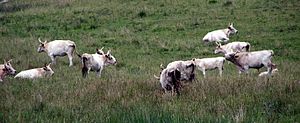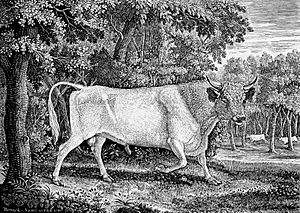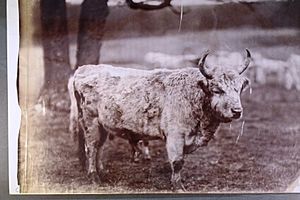Chillingham cattle facts for kids
Quick facts for kids Chillingham cattle |
|
|---|---|

A portion of the Chillingham cattle herd grazing
|
|
| Lua error in Module:Location_map at line 420: attempt to index field 'wikibase' (a nil value). | |
| Location | Northumberland, England, UK |
| OS grid | NU074256 |
Chillingham cattle, also known as Chillingham wild cattle, are a breed of cattle that live in a large enclosed park at Chillingham Castle, Northumberland, England. In 2009 the cattle were described as "about 90 animals in Chillingham, which inhabit a very large park that has existed since the Middle Ages". The herd has remained remarkably genetically isolated for hundreds of years, surviving despite inbreeding depression due to the small population. There is also a small reserve herd of about 20 animals located on Crown Estate land near Fochabers, North East Scotland.
Contents
Description of cattle
The Chillingham cattle are related to White Park cattle, in the sense that the Chillingham herd has contributed to the White Park, though there has been no gene flow the other way. Chillingham cattle are small, with upright horns in both males and females. Bulls weigh around 300 kg (660 lb), cows about 280 kg (620 lb). They are white with coloured ears (they may also have some colour on feet, nose and around the eyes). In the case of Chillingham cattle, the ear-colour is red – in most White Park animals the ears are black (which is genetically dominant over red in cattle). Chillingham cattle are of generally primitive conformation while White Parks are of classical British beef conformation. A brief review of academic studies on the Chillingham cattle is available.
Description of the Northumberland habitat
To many visitors, the most striking element of the historic habitat at Chillingham is the widespread occurrence of large oak trees amongst grassland (wood pasture), providing a glimpse of Britain as many think it appeared in medieval times. However, most of these trees were only planted in the 1780s - early 19th century, and the truly ancient trees of the park are the streamside alder trees, which were probably coppiced in the mid-18th century. They were probably hundreds of years old even then and the stems now growing are themselves around 250 years old. A diversity of plants and animals find a habitat here, due to the absence of the intensive farming found in most other places in Britain.
The Northumberland site is also home to a variety of other species including red squirrel, fox, and badger, as well as roe deer and fallow deer. There are approximately 55 bird species, including common buzzards, European green woodpeckers, and the Eurasian nuthatch which claims this latitude as its northernmost range in the United Kingdom.
An on-site warden at the park leads small groups on foot to find the Chillingham cattle herd; on some days they are evident in one of the easily accessible meadows, while on rare occasions they can be difficult to find without a fair bit of walking, given the tangled woodlands and the amount of space they have for roaming. Just to the east of the park is the summit of Ros Hill. The cattle are not visible from this viewpoint, which does however give an impressive view over much of north Northumberland. With support from Defra, a network of paths has been created around the periphery of Chillingham Park.
Ancestry and history of the Chillingham cattle

According to earlier publicity material produced by the Chillingham Wild Cattle Association, Chillingham cattle bear some similarities to the extinct ancestral species aurochs, Bos primigenius primigenius, based upon cranial geometrics and the positioning of their horns relative to the skull formation. They further claim that Chillingham cattle may be direct descendants of the primordial ox "which roamed these islands before the dawn of history"; moreover, according to Tankerville, these characteristics differed from the cattle brought into England by the Romans. It is now considered much more likely that they are descended from medieval husbanded cattle that were impounded when Chillingham Park was enclosed. But in the absence of adequate genetic or archaeological evidence, these proposed origins must remain purely speculative. However, the traditional view that these cattle have an unbroken line of descent, without intervening domestication, from the wild-living aurochs was already being called into question in the 1800s. Over the years a large popular literature has built up relating to the herd, which has been analyzed in relation to prevalent concepts of ownership and attitudes of people towards big, charismatic animals. Simon Schama described the famous contemporary woodcut by Thomas Bewick as "an image of massive power ... the great, perhaps the greatest icon of British natural history, and one loaded with moral, national and historical sentiment as well as purely zoological fascination".
The first written record of the herd dates from 1645, but the Chillingham herd is claimed by some to have been in this site for at least seven centuries. Before the 13th century, this breed is claimed to have "roamed the great forest which extended from the North Sea coast to the Clyde estuary" according to the Countess of Tankerville. During the 13th century, the King of England licensed Chillingham Castle to become "castellated and crenellated" and a drystone wall may well have been built then to enclose the herd. At that time, there was particular concern about Scottish marauders, which explains also the massive build-up of fortification of the nearby Dunstanburgh Castle at the same time.
The wall that visitors see at Chillingham was built in the early 19th century to enclose the 1,500 acres (610 ha) of Chillingham Park. As of 2009, the cattle have 330 acres (130 ha) to roam and the rest of the ground is woodland or farmland.
Genetics
Chillingham bulls contributed genetically to White Park herds in the early 20th century, but the Chillingham herd has remained pure. Some degree of genetic affinity between Chillingham and White Park cattle would therefore be predicted, but this has not been investigated. On historical grounds they are probably particularly closely related to the Vaynol cattle breed.
The first genetic work was conducted from the early 1960s when, in connection with the development of blood typing techniques for cattle parentage testing, Dr. J. G. Hall of the Animal Breeding Research Organisation (Edinburgh) studied the blood groups of the Chillingham herd. The herd was found to be remarkably homozygous, and this is what would be expected from their long history of inbreeding. These findings were confirmed in a later microsatellite DNA study. Mitochondrial DNA is of the same T3 sub-haplogroup as most European cattle though Chillingham cattle do possess certain rare variants; it is not yet clear what the implications are for understanding the history and continuing survival of the breed. There is remarkably little genetic variation in genes understood to be concerned with disease resistance.
Behaviour
The Chillingham cattle herd are not tamed in any way, and behave as wild animals. Their behaviour may therefore give some insight into the behaviour of ancestral wild cattle. In the past there has been conflation of the terms "tamed" and "domesticated" and while these cattle are descendants of domesticated animals, there is no handling or taming of individuals. The term "wild" as applied to the Chillingham cattle reflects this conflation but is firmly established historically.
They breed all year round and this has clear effects on the detailed structure of their behaviour and bulls occupy and share "home territories" with other members of the herd, and with two or three, or more, other bulls. Home ranges overlap, and are not thought of as defended territories although bulls participate in sparring matches with their home range partners. Studies during winter hay feeding showed that at this time when the cattle were forced into close proximity, cows had a complex social structure apparently based on individual pairwise relationships, while bulls had a linear hierarchy or "peck order". Those studies were made many years ago and the feeding system now in operation does not bring the cattle into such close proximity. The cattle are extremely vocal with characteristic calls which echo around the area, especially when the bulls are excited by the discovery that a cow is coming into season.
Traditionally, the herd has been regarded as having a "king bull" system whereby one bull sires all calves during the period of his "reign" which lasts maybe 2–3 years until he is deposed, usually violently, by a challenger. While this may well have been the case when herd numbers were low, it is less likely to have been in effect when the herd has been numerous.
Modern history
In 1939, the Chillingham Wild Cattle Association Limited was formed to study and protect these special creatures; in 1963 it became a registered charity. However the herd's population decreased, and reached a minimum in the unusually hard winter of 1946-1947, which only 13 animals survived. Upon the death of Lord Tankerville in 1971 the Chillingham herd was bequeathed to the Association; however, when the estate was sold in 1980, with the help of Duke of Northumberland the park was purchased by the Sir James Knott Trust (a philanthropic organisation dedicated to protecting Northumberland for the benefit of all). It was then managed by the Knott Trust's agents: College Valley Estates (CVE). CVE granted a 999-year lease of the park to the association. In 2005, after a fund-raising campaign, the association purchased the park and surrounding woodlands. Thus, the herd and the park were reunited under the same ownership. Soon after, the association was able to purchase the sheep grazing rights, which were owned by a neighbour. The flock was removed, and this means a programme of remediation of the pasture and trees can be put into effect.
These cattle have a rather unusual status, being of a husbanded species but living as a wild animal. As being of the bovine species, they would be culled if they contracted foot-and-mouth disease. Special considerations apply to health monitoring and maintenance of biosecurity is a matter of the highest priority.
In March 2015, the herd numbers about 100 animals, approximately equal numbers of males and females. As a result of the absence of sheep since 2005, pasture is abundant in summer and fertility rates and body weights are increasing. Under such conditions, the tendency for better male survival is as predicted (work in preparation). There is also a small reserve herd of about 20 head located on Crown Estates land near Fochabers in north-east Scotland. News about the herd, and further information, is posted at the website of the Chillingham Wild Cattle Association.
Other herds of white cattle

The first list of herds of park cattle was compiled by Thomas Bewick in his A General History of Quadrupeds of 1790; Chartley, Chillingham, Gisburne, Lyme Park and Wollaton. Cadzow (Chatelherault) was not included. There is much vagueness over the history of many, perhaps most, of these and of the other herds of white park type. The standard scholarly work is still Whitehead's The Ancient White Cattle of Britain and their Descendants. In 1759 the Earl of Eglinton formed a herd of the ancient breed of white or Chillingham cattle at Ardrossan in North Ayrshire, Scotland, probably using stock from the Cadzow Castle herd. The numbers dropped and in 1820 the remaining animals were dispersed. All the animals in this herd were hornless.





